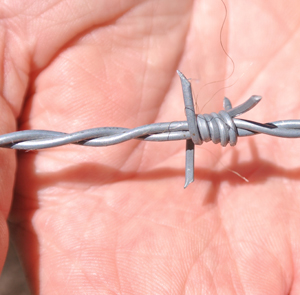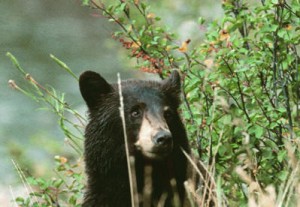The California Department of Fish and Wildlife is currently undertaking a county-wide census of the black bear population in San Luis Obispo County. The study comes three years after ForestWatch, local elected officials, and hundreds of County residents opposed a plan to allow bear hunting due to the lack of data about the size and extent of the bear population in the region. That plan was scrapped pending completion of a scientifically-sound bear population study.

Image courtesy CDFW
Now, CDFW biologists have set up 54 stations across the backcountry this summer incorporating large barbed-wire enclosures baited to attract local black bears and collect tufts of their fur. The fur samples are sent to the UC Davis Wildlife Genetics and Population Health Lab for DNA testing and analysis; the results of the analysis should provide a comprehensive profile of the area’s black bear population.
In September 2010 California Department of Fish & Game (as CDFW was then known) formally withdrew its proposal to allow the first-ever black bear hunting season in San Luis Obispo County, which would have allowed the hunting of more than 50 bears per year. ForestWatch sent a letter to the Commission outlining how legally and scientifically unsound the proposal was, and this along with other pressures led to the withdrawal of the flawed proposal.
“This is the first large-scale genetic sampling of black bears in the state that we’ve ever done,” said Marc Kenyon, coordinator for the state Department of Fish and Wildlife’s black bear program in a recent article published in The Tribune.
According to CDFW, hair sampling is one of the most cost-effective and increasingly common methods of estimating abundance and density of bears on local scales. The method, known as capture–mark-recapture, is commonly used to estimate population sizes of wildlife, particularly when a complete head count is not possible.
Population size is estimated when a portion of the population is “captured” via a hair snag, “marked” by a DNA profile and “recaptured” when hair from the same animal is collected again. By evaluating the proportion of bears whose hair is collected repeatedly to the total number of bears sampled, scientists can estimate population size and identify general trends.
 The San Luis Obispo county program began in late June and will conclude in August, and will cost $95,000. A federal wildlife grant covered 80 percent of the cost, with state funds from hunting license and tag fees paying for the rest. The program heads north to Monterey County in the fall.
The San Luis Obispo county program began in late June and will conclude in August, and will cost $95,000. A federal wildlife grant covered 80 percent of the cost, with state funds from hunting license and tag fees paying for the rest. The program heads north to Monterey County in the fall.
(Read more about population genetic analysis of black bears in California here.)
Los Padres ForestWatch will track the results of the study to ensure planning decisions are informed and made in the best interest of bears.







Comments are closed.